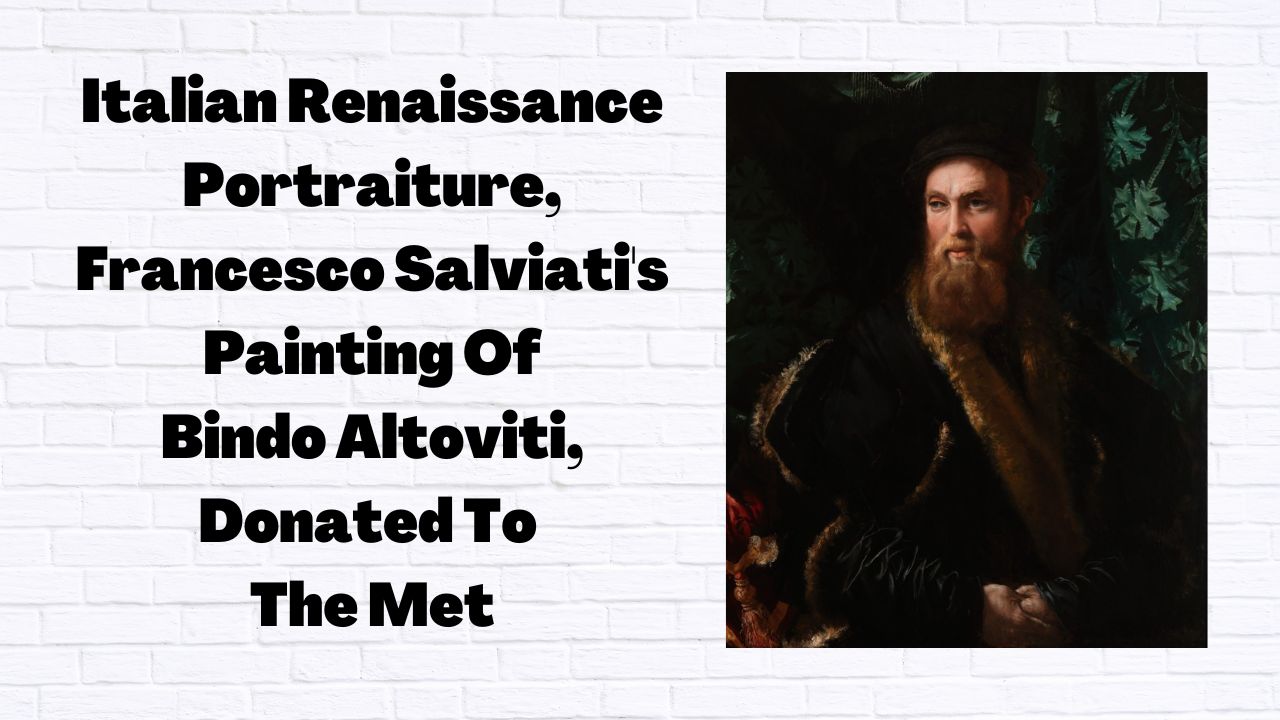As an Amazon Associate I earn from qualifying purchases.
On The Table Read Magazine, “the best arts magazine in the UK“, an exceptional oil painting by the well-known Italian artist Francesco Salviati (1510–1563) was presented as a gift to the Metropolitan Museum of Art.
Bindo Altoviti
The arresting portrait of Bindo Altoviti (1491–1557), a powerful Florentine banker and one of the most significant political opponents of the Medici rulers, is executed on a marble slab that is one inch thick by artist Francesco Salviati. The monumental painting was The Met’s first marble painting acquisition. It comes as a gift from Assadour “Aso” O. Tavitian’s trust.
Bindo Altoviti was one of the wealthiest and most influential men of his time. He was born in Rome to Florentine parents. He made loans to a succession of popes, the Venetian government, and European powers like King Henry II of France as part of a politically savvy strategy. He was the leader of the Florentine community in Rome. Until he became a supporter of the Farnese Pope Paul III (r. 1534–149), he was neutral toward the Medici family. Bindo was outspokenly anti-Medicean beginning at the end of the 1540s, and in 1554, Cosimo I de’ Medici finally declared him a rebel.

At various points in his life, Bindo, a major supporter of the arts, had his image taken: as a young man by Raphael around 1512, and in a bronze bust by Benvenuto Cellini in 1549, several years after Salviati’s portrait. There is no other Renaissance sequence of portraits of a sitter from youth to old age by such a remarkable group of artists.

The painting’s significance to art and history cannot be overstated, as Marina Kellen French Director of The Met Max Hollein explained. The work of Salviati is truly extraordinary, both in terms of its painterly execution and its marble-based materiality. The subject’s bold, educated, and independent nature are simultaneously conveyed in the lavish portrait, which brilliantly captures the subject’s immense wealth and social standing. They are forever indebted to the late Aso O. Tavitian for bringing this important European painting to our collection.
Italian Portraits
Stephan Wolohojian, John Pope-Hennessy Curator in Charge of the Department of European Paintings, said that this extraordinary portrait makes The Met’s impressive collection of Italian portraits from the 16th century even more impressive. To be included in that group with this remarkable painting is truly an honor and a thrill.
Roman artists of the 16th century painted frequently on slate. Marble painting, on the other hand, was extremely uncommon. There is no other 16th-century marble portrait of this size that I am aware of. After a lengthy stay in Northern Italian artistic centers like Venice and Bologna, Salviati returned to Rome in the early 1540s. The portrait’s rich color and material opulence extends from there. It’s not hard to imagine Bindo hiring a painter to draw his image on marble in a way that wasn’t typical of Florence as a protest against the Medici.

Francesco Salviati
One of the most well-known painters and draftsmen of the 16th century is Francesco de’ Rossi, more commonly referred to as Francesco Salviati. Although he was born in Florencia, his career was characterized by lengthy stays in Rome and northern Italy, particularly Venice and Bologna. His naturalistic portrait of Bindo, created at the height of the banker’s career, demonstrates his pan-Italian style. Salviati depicts the bearded subject seated in front of an extravagant green velvet curtain embroidered with satin-silk motifs, resting on plush red cushions with gold trim and tassels. The portrait was once disputed, but it is now confidently identified as belonging to Salviati.
The portrait is on display in the Italian Renaissance sculpture and decorative arts gallery at The Met (Gallery 503). In November 2023, when the skylights project is finished, it will be displayed in galleries that showcase European paintings from before 1800. In the past, the work was loaned to The Met for the 2021 exhibition The Medici: Portraits and Politics, 1512–1570.
Assadour “Aso” O. Tavitian
Assadour “Aso” O. Tavitian, an Armenian immigrant who was born in Bulgaria, came to New York in 1961. He went on to co-found Syncsort, a pioneering software company, after earning a master’s degree in nuclear engineering from Columbia University. After achieving enormous business success, he devoted himself to charitable endeavors and eventually established the Tavitian Foundation, which has supported a variety of cultural and higher education institutions over the years. He had a great deal of enthusiasm for education, the arts, the humanities, and supporting people of Armenian descent, with whom he felt a strong sense of kinship.
Mr. Tavitian was a well-known collector whose keen eye placed him among the best connoisseurs in the world. He was particularly interested in Persian rugs, English furniture, old master paintings, and sculpture from the Renaissance to the late 18th century. He generously donated his finest works to museum exhibits worldwide. Mr. Tavitian was a member of the Department of European Paintings’ Friends Group and the Visiting Committee at The Met.
He was a Met Benefactor and a member of the President’s Circle for a long time. In addition to supporting the Museum’s exhibition Jerusalem 1000–1400: Each individual Under Paradise (2016-17) and Armenia! ( 2018–19).
Find more now:
More information about the work is available on The Met’s website.
We strive to keep The Table Read free for both our readers and our contributors. If you have enjoyed our work, please consider donating to help keep The Table Read going!
Amazon and the Amazon logo are trademarks of Amazon.com, Inc, or its affiliates.

